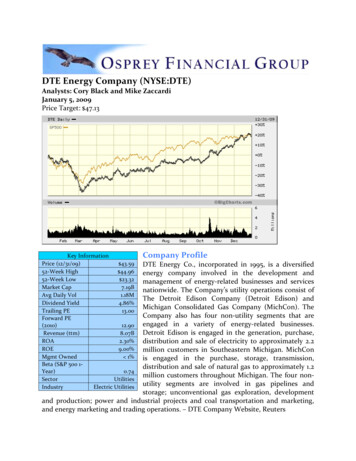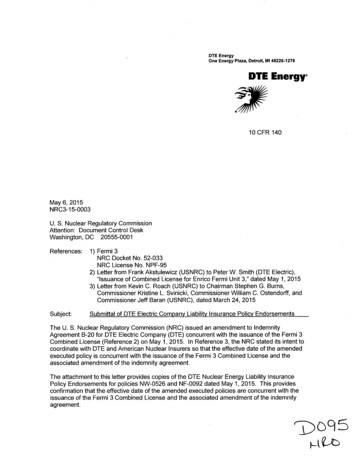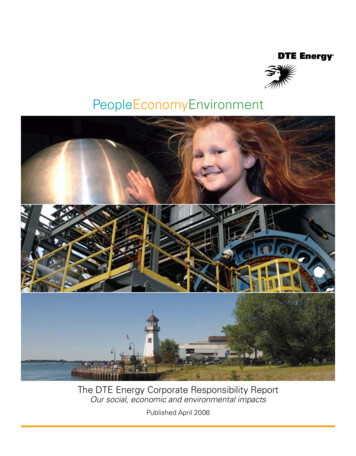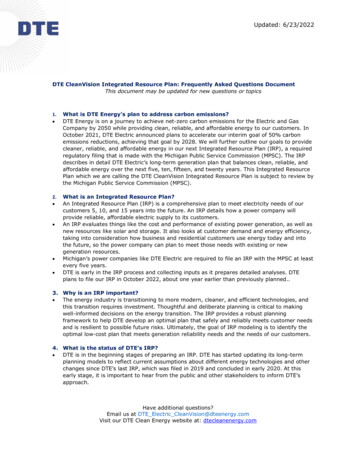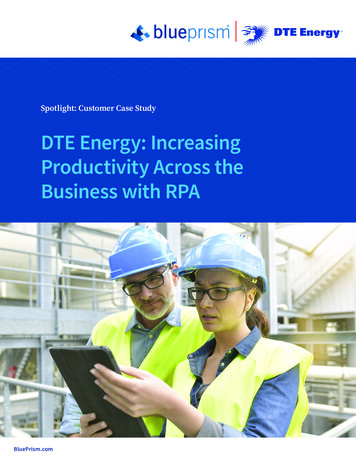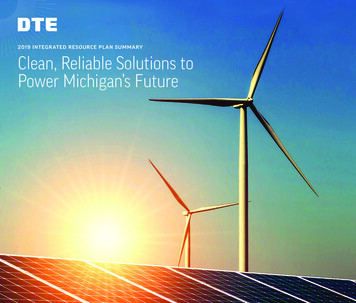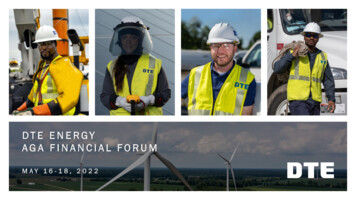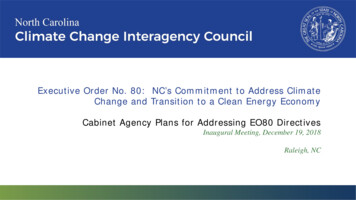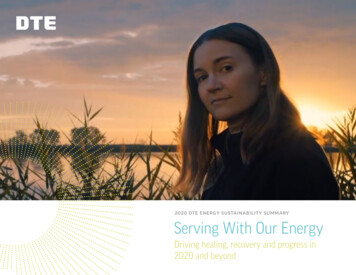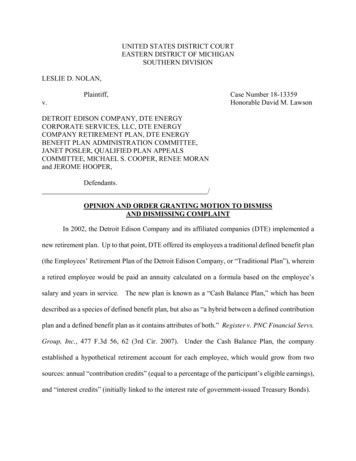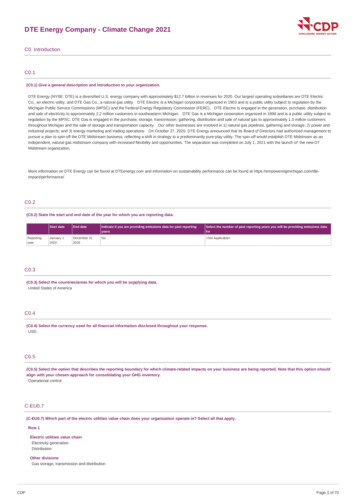
Transcription
DTE Energy Company - Climate Change 2021C0. IntroductionC0.1(C0.1) Give a general description and introduction to your organization.DTE Energy (NYSE: DTE) is a diversified U.S. energy company with approximately 12.7 billion in revenues for 2020. Our largest operating subsidiaries are DTE ElectricCo., an electric utility, and DTE Gas Co., a natural gas utility. DTE Electric is a Michigan corporation organized in 1903 and is a public utility subject to regulation by theMichigan Public Service Commissions (MPSC) and the Federal Energy Regulatory Commission (FERC). DTE Electric is engaged in the generation, purchase, distributionand sale of electricity to approximately 2.2 million customers in southeastern Michigan. DTE Gas is a Michigan corporation organized in 1898 and is a public utility subject toregulation by the MPSC. DTE Gas is engaged in the purchase, storage, transmission, gathering, distribution and sale of natural gas to approximately 1.3 million customersthroughout Michigan and the sale of storage and transportation capacity. Our other businesses are involved in 1) natural gas pipelines, gathering and storage; 2) power andindustrial projects; and 3) energy marketing and trading operations. On October 27, 2020, DTE Energy announced that its Board of Directors had authorized management topursue a plan to spin-off the DTE Midstream business, reflecting a shift in strategy to a predominantly pure-play utility. The spin-off would establish DTE Midstream as anindependent, natural gas midstream company with increased flexibility and opportunities. The separation was completed on July 1, 2021 with the launch of the new DTMidstream organization.More information on DTE Energy can be found at DTEenergy.com and information on sustainability performance can be found at ce/C0.2(C0.2) State the start and end date of the year for which you are reporting data.ReportingyearStart dateEnd dateIndicate if you are providing emissions data for past reportingyearsSelect the number of past reporting years you will be providing emissions dataforJanuary 12020December 312020No Not Applicable C0.3(C0.3) Select the countries/areas for which you will be supplying data.United States of AmericaC0.4(C0.4) Select the currency used for all financial information disclosed throughout your response.USDC0.5(C0.5) Select the option that describes the reporting boundary for which climate-related impacts on your business are being reported. Note that this option shouldalign with your chosen approach for consolidating your GHG inventory.Operational controlC-EU0.7(C-EU0.7) Which part of the electric utilities value chain does your organization operate in? Select all that apply.Row 1Electric utilities value chainElectricity generationDistributionOther divisionsGas storage, transmission and distributionCDPPage 1 of 70
C-OG0.7(C-OG0.7) Which part of the oil and gas value chain and other areas does your organization operate in?Row 1Oil and gas value chainMidstreamOther divisionsBiofuelsGrid electricity supply from gasGrid electricity supply from coalGrid electricity supply from renewablesC1. GovernanceC1.1(C1.1) Is there board-level oversight of climate-related issues within your organization?YesC1.1a(C1.1a) Identify the position(s) (do not include any names) of the individual(s) on the board with responsibility for climate-related issues.Position of Please explainindividual(s)ChiefExecutiveOfficer(CEO)Our President and CEO, together with other senior leaders of the company, exercise leadership in our sustainability initiatives. Through the Executive Committee, Government Regulatory Committee,Force for Growth Committee, ESG Committee and other leadership committees, DTE Energy’s senior management: Executes the company’s Environmental, Social, and Governance (ESG)strategy in consultation with the Board of Directors Manages our environmental compliance processes and carbon reduction aspirations Mobilizes our employees, resources and partnerorganizations to strengthen and promote prosperity in our communities Reports to Board of Directors on outcomes of ESG initiatives Manages risks associated with environmental andsustainability opportunities Receives compensation tied to achievement of company goals, including ESG targets An example of a decision made by our CEO related to climate: In September 2020,after a thorough review of feasibility options, our CEO recommended to the Board of Directors to announce a net zero by 2050 goal for DTE Electric generation.Other,The Board continues to believe a good governance practice is to elect a Lead Independent Director. The Lead Independent Director will have such responsibilities as required under the NYSE listingpleasestandards, as well as such other responsibilities as determined by the Board, including approving the agenda for Board discussions of strategic issues (including climate-related issues) for thespecify (Lead company.IndependentDirector)C1.1bCDPPage 2 of 70
(C1.1b) Provide further details on the board’s oversight of climate-related issues.Frequencywithwhichclimaterelatedissues areascheduledagendaitemGovernancemechanismsinto whichclimaterelated issuesare integratedScope of Please explainboardleveloversightScheduled Reviewing and Not– allguidingApplicablmeetingsstrategye Reviewing andguiding majorplans of actionReviewing andguiding riskmanagementpoliciesReviewing andguiding annualbudgetsReviewing andguidingbusiness ntationandperformance ofobjectivesOverseeingmajor itoring andoverseeingprogressagainst goalsand targets foraddressingclimate-relatedissuesClimate-related issues impact all areas of DTE Energy's business and are therefore incorporated into the agenda at all Board meetings. Examples include obtainingapproval from the Board for the company's 2050 carbon reduction goal announced in 2017 and updated in 2019, long-term strategies and action plans to meet these goals,risks associated with meeting or not meeting these goals, capital expenditures necessary to meet these goals, and setting milestone targets to track and measure progresstowards these goals. The Public Policy and Responsibility Committee (PPRC) of the DTE Energy Board of Directors is responsible for reviewing and advising the Board onemerging social, economic, political, reputational and environmental issues that could significantly affect the Company's business and performance in relation to thecommunity, shareholders, customers and employees. The PPRC's responsibilities and duties include direct responsibility for climate change issues that affect theCompany. The Committee met 5 times in 2020. The PPRC's Charter is available on our website and includes the following statements on Membership & Authority: 1. TheCommittee shall be composed of three or more directors as determined by the Board of Directors. Committee members are appointed for one-year terms and can be reappointed for additional terms. 2. The Committee has the authority to perform the duties listed in this Charter, as it determines to be necessary and advisable from time totime in its business judgment. 3. The Committee shall meet as necessary, but no fewer than three times a year. The Committee shall keep minutes or other records of itsmeetings. 4. The Committee has the authority to retain independent outside professional advisors or experts as it deems advisable or necessary, including the soleauthority to retain and terminate any such advisors or experts, to carry out its duties. The Committee shall have sole authority to approve related fees and retention terms.C1.2(C1.2) Provide the highest management-level position(s) or committee(s) with responsibility for climate-related issues.Name of the position(s) and/or committee(s)Reporting ResponsibilitylineCoverage ofresponsibilityFrequency of reporting to the board onclimate-related issuesOther, please specify (Vice President Environmental Management & Safety) NotBoth assessing and managing climateApplicable related risks and opportunities Not Applicable QuarterlyOther committee, please specify (ESG Committee) NotManaging climate-related risks andApplicable opportunities Not Applicable As important matters ariseOther, please specify (Force for Growth Committee) NotManaging climate-related risks andApplicable opportunities Not Applicable As important matters ariseOther committee, please specify (Executive Committee, Government, Regulatory andCommunity Committee, Risk Management Committee) NotBoth assessing and managing climateApplicable related risks and opportunities Not Applicable As important matters ariseChief Executive Officer (CEO) NotBoth assessing and managing climateApplicable related risks and opportunities Not Applicable QuarterlyC1.2aCDPPage 3 of 70
(C1.2a) Describe where in the organizational structure this/these position(s) and/or committees lie, what their associated responsibilities are, and how climaterelated issues are monitored (do not include the names of individuals).The VP-Environmental Management & Safety reports directly to the President and COO of DTE Electric and oversees the company's environmental operations. Thisresponsibility is given to the VP-Environmental Management & Safety so that a high-level executive position has the main responsibility of overseeing environmentaloperations under the direction of C-suite officers. In managing our sustainability initiatives, the VP-Environmental Management & Safety: Represents the company on environmental issues with the public and in environmental regulatory and legislative development Coordinates environmental studies and conducts environmental audits Supervises a department of approximately 100 peopleENVIRONMENTAL, SOCIAL AND GOVERNANCE (ESG) COMMITTEEThe cross-functional ESG Committee was formed to coordinate and execute the company’s multiple streams of ESG disclosure. The ESG Committee has members fromlegal, corporate communications, human resources, investor relations, environmental compliance, public affairs, and the corporate secretary's office. The Committee is giventhe responsibility of coordinating the company's ESG strategies and disclosures. The multiple disciplines and business units represented on the ESG Committee allow themto make climate-related recommendations and decisions that benefit the entire company. The ESG Committee:Evaluates potential ESG disclosure platforms and templates, and makes recommendations to managementReviews peer company disclosures for best practicesCollects internal ESG data and drafts disclosure documents in consultation with relevant business unitsIncorporates input from management and board reviewersMeets at least monthly SENIOR MANAGEMENT — GOVERNMENT, REGULATORY AND COMMUNITY (GRC) AND FORCE FOR GROWTH (FFG) COMMITTEESOur President and CEO, together with other senior leaders of the company, exercise leadership in our sustainability initiatives through executive committees. The GRC andFFG committees include C-suite officers and other senior management as members. Through monthly meetings of the GRC, FFG, and other leadership committees, DTEEnergy’s senior management:Executes the company’s ESG strategy including governance, engagement and oversight in consultation with the Board of DirectorsManages our environmental compliance processes and carbon reduction strategyManages the progress of our diversity, equity and inclusion strategies through the oversight of the Executive Diversity, Equity and Inclusion Steering CommitteeMobilizes our employees, resources and partner organizations to strengthen and promote prosperity in our communities through the oversight of the Force for GrowthPriority CommitteeReports the outcomes of our ESG initiatives to the Board of DirectorsManages risks and opportunities associated with environmental and social initiativesReceives compensation tied to achievement of company goals, including ESG targets Senior management is given these responsibilities in order to provide high-level direction toward climate-related initiatives for the rest of the company.C1.3(C1.3) Do you provide incentives for the management of climate-related issues, including the attainment of targets?Provide incentives for the management of climate-related issuesRow 1CommentYesC1.3aCDPPage 4 of 70
(C1.3a) Provide further details on the incentives provided for the management of climate-related issues (do not include the names of individuals).EntitledtoincentiveType of ActivityCommentincentive inventivizedChiefExecutiveOfficer(CEO)Monetary EmissionsrewardreductiontargetOur CEO received 64% of his 2020 total compensation in contingent, performance-based incentives that are focused on meeting our system of corporate priorities, includingour target to reduce carbon emissions. For our other named executive officers, the average percentage of contingent, performance-based compensation was 40%. Our shortterm and long-term performance metrics all tie directly to our system of priorities. These are the same metrics that management uses to assess the Company’s progress towardour aspiration of becoming the best-operated energy company in North America and a force for growth and prosperity in the communities where we live and serve.AllMonetary Otheremployees The company utilizes scorecards as a means to measure progress towards meeting company goals. The scorecards are utilized to assess annual incentive awards at thebusiness unit level for all employees. Examples of corporate level priorities related to climate change that were tracked on scorecards at the business unit level in 2019included the following: 1. Reduce carbon emissions 21% below 2005 (on way to 80% reduction by 2050) 2. Achieve annual customer electricity savings of 1.5% 3. Achieveannual customer gas savings of 1.0% 4. Drive 25% energy, water and waste reduction from 2016 levels by 2022AllMonetary Otheremployees reward(pleasespecify)(Alex DowAward)Alex Dow Award - The Alex Dow Award recognizes outstanding achievement related to the company’s operation that is consistent with its responsibilities as an investor-ownedutility and exemplifies DTE Energy’s Core Values and incorporates the DTE Energy Operating System principles. Awards fall into the following categories: 1. Achievement orInnovation: An original achievement or innovation that has significant positive impact on corporate cost savings or increased revenues, gained outside recognition, andsupports corporate strategies. 2. Emergency: An individual(s) taking extraordinary action in an emergency to prevent injury, loss of life, or damage to or loss of property. 3.Improved Operation: An outstanding individual(s) effort, beyond normal responsibilities, which significantly improved company-wide operations, greatly impacted the company'sfinancial success and supported corporate strategies. 4. Human Relations: An outstanding, sustained individual effort that has had a significant impact on improving the qualityof life in the Community or the Company. 5. Public Relations: An outstanding, sustained individual effort that has had a significant impact on improving the corporate serviceand awareness in the communities in which we serve 6. Above and Beyond: Exceptional, consistent, and sustained efforts to achieve business success that goes above andbeyond and exceeds expectations. 7. Lifetime Achievement: Original achievements and innovations that have had a sustained impact on the corporation and gained outsiderecognition. The Alex Dow award is one of 3 established employee performance recognition programs. Although these programs do not specifically target management ofclimate change issues, recipients have been awarded this honor in the past who are instrumental in creating and sustaining many environmental initiatives.AllNonOtheremployees monetary (pleaserewardspecify)(SarahSheridanAward)Sarah Sheridan Award - The Sarah Sheridan award recognizes the commitment, innovation and sustained efforts of employees that provide Service Excellence to our externaland internal customers, and our community (including volunteerism). Such efforts by an individual or team epitomize our Service Key behaviors. The Sarah Sheridan Award isone of 3 established employee performance recognition programs. Although these programs do not specifically target management of climate change issues, recipients havebeen rewarded for their work in climate change or related environmental issues.AllMonetary Otheremployees reward(pleasespecify)(Walter J.McCarthyAward)Walter J. McCarthy, Jr. Award - Through the Walter J. McCarthy Volunteer Leadership Individual Grant Program, the DTE Energy Foundation awards up to 1,000 on behalf ofits employees and retirees who volunteer personal time with eligible non-profit organizations in Michigan. The Walter J. McCarthy, Jr. Award is one of 3 established employeeperformance recognition programs. Although these programs do not specifically target management of climate change issues, recipients are often rewarded for their work inclimate change or related environmental issues.AllMonetary OtherThe EV Incentive program allows eligible DTE Energy employees to receive a 2,000 incentive for purchasing or leasing a new Electric Vehicle (EV) from January 1- Novemberemployees reward(please30, 2020. The Charging Forward program allows eligible DTE Energy employees to receive 500 rebate on the purchase and installation of a qualified Level 2 charger afterspecify)the purchase or lease of an EV.(Employeeengagementto reduceemissions)C2. Risks and opportunitiesC2.1(C2.1) Does your organization have a process for identifying, assessing, and responding to climate-related risks and opportunities?YesC2.1a(C2.1a) How does your organization define short-, medium- and long-term time horizons?From (years) To (years) CommentShort-term5Aligned with annual planning cycles and shorter term targets to reach performance goals.Medium-term 5015Generally aligned with Integrated Resource Plan timeframe and other regulatory submittals and disclosures required by the Michigan Public Service Commission.Long-term30Aligned with DTE Energy's goal to achieve net zero carbon emissions by 2050.15C2.1bCDPPage 5 of 70
(C2.1b) How does your organization define substantive financial or strategic impact on your business?DTE identifies issues that are material to its financial or strategic planning in required financial filings to the Securities and Exchange Commission (e.g. annual 10-K reports).SEC provides guidance on reporting material issues in financial statements in SEC Staff Accounting Bulletin No. 99, August 12, 1999. The Bulletin suggests that a mix ofquantitative and qualitative information is necessary to evaluate the materiality of an aspect or issue. The definition of materiality extends to any financial and strategic impactthat an investor would deem substantive, and DTE aims to maintain a reputation of sound risk assessment and management among its investors. For example, extremeweather conditions are identified as a risk in our 2020 10-K Annual Report, which we would consider a substantive financial or strategic impact if it caused damage to theelectric distribution system infrastructure and power generation facilities. The 2019 Polar Vortex is an example of an event we would consider substantive; very cold-weathermay impact normal daily operations our facilities. Recovering from these setbacks would result in increased costs from unforeseen maintenance to our power generationfacilities, therefore negatively impacting the financial performance of the company.A brief explanation of the more significant risks associated with DTE Energy's businesses are provided in our 2020 Form 10-K annual report. Although we have tried toidentify and discuss key risk factors, others could emerge in the future. Key risk factors related to climate change include the following:We are subject to rate regulation.Changes to Michigan's electric retail access program could negatively impact our financial performance.Our electric distribution system and our gas distribution system are subject to risks from their operation, which could reduce revenues, increase expenses, and have amaterial adverse effect on their business, financial position, and results of operations.DTE Energy's non-utility businesses may not perform to expectationsEnvironmental laws and liability may be costly.Construction and capital improvements to our power facilities, distribution systems and its Gas Storage and Pipelines business subject us to risk.Operation of a nuclear facility subjects us to risk.The supply and/or price of energy commodities and/or related services may impact our financial results.The supply and/or price of other industrial raw and finished inputs and/or related services may impact our financial resultsEmerging technologies may have a material adverse effect.Our participation in energy trading markets subjects us to risk.Weather significantly affects operations.Unplanned power plant outages may be costly.Renewable portfolio standards and energy waste reduction may affect our business and federal and state fuel standards may affect DTE Energy's non-utility investments.Our ability to utilize production tax credits may be limited.Regional, national and international economic conditions can have an unfavorable impact on us.If DTE Energy's goodwill becomes impaired, it may be required to record a charge to earnings.We may not be fully covered by insurance. Finally, long-range planning risks associated with the transition of DTE's generating fleet to less carbon-intensive technologies are addressed through the company'sIntegrated Resource Planning process. These risks include increasing pressure by investors and other stakeholders to conduct climate scenario analyses demonstrating thecompany's commitment to limiting global warming to less than 2-degrees C above pre-industrial levels.C2.2CDPPage 6 of 70
(C2.2) Describe your process(es) for identifying, assessing and responding to climate-related risks and opportunities.Value chain stage(s) coveredDirect operationsRisk management processIntegrated into multi-disciplinary company-wide risk management processFrequency of assessmentMore than once a yearTime horizon(s) coveredShort-termMedium-termLong-termDescription of processGovernance Process for Evaluating Which Risks and Opportunities Could Have a Substantive Financial or Strategic Impact: Each Board Committee is responsible foroverseeing and considering risk issues relating to their respective Committee and reporting their assessments to the full Board at each regularly scheduled Board meeting.When granting authority to management, approving strategies and receiving management reports, the Board and Committees consider, among other things, the risks weface. The following committees review management's assessment of risk for that Committee's respective area of responsibility: Audit Committee Finance CommitteeOrganization and Compensation Committee Corporate Governance Committee Nuclear Review Committee Public Policy and Responsibility Committee The charters foreach of these committees are posted on the DTE Energy website. The Company also utilizes an internal Risk Management Committee, chaired by the Chairman, Presidentand CEO and comprised of the Chief Financial Officer, Chief Risk Officer, General Counsel, General Auditor and other senior officers, that, among other things, directs thedevelopment and maintenance of comprehensive risk management policies and procedures, and sets, reviews and monitors risk limits on a regular basis for enterpriselevel risks. The Company's Chief Risk Officer attends all Audit Committee meetings and meets annually with either the joint Audit Committee and Finance Committee or thefull Board to update the members on the Company's enterprise-level risk management. The Chief Risk Officer also periodically meets with the other Board Committees andthe full Board as may be required. These periodic meetings allow for two-way exchange of company and asset related risk, either from the business unit level that hasidentified an asset related risk, or from the Board Committee that may have a generally identified risk that could impact assets. The Public Policy and ResponsibilityCommittee (PPRC) of the DTE Energy Board of Directors is responsible for addressing climate change issues that affect the Company. The PPRC Committee met 5 timesin 2020. The Board receives, reviews and assesses reports from the Board Committees and from management relating to enterprise-level risks, including climate risks.DTE Energy's long-term planning, including management of climate-related risk, is guided by our commitment to reduce carbon emissions to net zero by 2050. Climaterelated issues impact all areas of DTE Energy's business and are therefore incorporated into the agenda at all Board meetings. Case Study 1: in response to transitionalrisk identified in C2.3, our CEO recognized the need to go beyond our DTE Electric carbon reduction goals outlined in the March 2019 Integrated Resource Plan andobtained approval from the Board for DTE Electric's updated net zero goal announced in September 2019. This goal requires the development of strategies and actionplans to meet these goals in the short, medium and long-term horizons, risks associated with meeting or not meeting these goals, potential capital expenditures necessaryto meet these goals, and setting milestone targets to track and measure progress towards these goals. These goals require an evaluation of risk to meet the following short,medium and long-term carbon reduction goals: 32 percent below 2005 by 2023 50 percent below 2005 by 2030 80 percent below 2005 by 2040 Net zero by 2050Furthermore, recognizing the increasing external stakeholder pressure on the role of the oil and gas industry's role in climate change, DTE announced a net zero goal for itsgas utility in June 2020. The holistic three-fold approach will include natural gas suppliers to operate at net zero greenhouse gas emissions by 2050; DTE Gas operations,both combustion and fugitive emissions, will also achieve net zero by 2050; and partnerships with customers on energy efficiency and voluntary offsets will reduce theiremission by approximately 35% by 2050. Case Study 2: DTE is working to build a 21st century grid that meets the customer needs of tomorrow, and that will help tominimize the impacts from increased physical risks due to climate change such as ice storms, tornadoes, or high winds, as well as building a grid that accommodates theneeds of an increasingly decarbonized electricity sector. In response to an order from the Michigan Public Service Commission, DTE Electric developed a DistributionOperations Five-Year (2018-2022) Investment and Maintenance Plan in 2018 that provides a detailed summary of the current state of DTE's distribution infrastructure andthe needs of the future. DTE has planned, approved and disclosed in the 2020 10K that DTE Electric's capital investments over the short-term 2021-2025 period areestimated at 7 billion for distribution infrastructure. These investments will include infrastructure resilience and hardening to help minimize the impacts from increasedphysical risks due to climate change; infrastructure redesign to increase system capacity (which will accommodate demand growth due to electrification); and technologyand automation including smart meters and technologies to incorporate distributed energy resources such as rooftop solar.C2.2aCDPPage 7 of 70
(C2.2a) Which risk types are considered in your organization's climate-related risk assessments?Relevance Please ncludedAn example of assessed current regulations are the U.S. EPA rules under the Clean Air Act that impose limits on air emissions, including greenhouse gases. U.S. EPA rules under theClean Air Act requiring carbon performance standards for new and existing electric generating unit (EGU) sources of greenhouse gases under Sections 111(b) and 111(d) of the Clean AirAct were finalized in 2015. The 111(d) rule for existing sources, also known as the Clean Power Plan, was repealed in June 2019 and replaced with the Affordable Clean Energy Rule.Though now repealed, DTE Energy was able to assess this risk by engaging extensively with U.S. EPA on influencing a final rule for the Clean Power Plan that was reasonable andaffordable for the electric power industry. DTE also assessed this regulation-related risk by determining how the Clean Power Plan, as proposed, could impact the reliability of the nation'selectric grid; our CEO Gerry Anderson spoke on behalf of DTE and EEI on this topic in 2015. Our CEO (now Chairman) continues to influence the industry on climate related issuesthrough his role as EEI Chairman. Regulation pertaining to renewable energy and/or clean energy requirements is also considered. In late 2016, Michigan passed legislation requiringelectricity providers to meet a 12.5% renewable portfolio standard by 2019 and 15% by 2021 and an energy optimization goal of meeting at least 35% of the State's electric needs throughenergy waste reduction and renewable energy by 2025. The Michigan energy legislation also requires periodic submittal of an Integrated Resource Plan (IRP) to the Michigan PublicService Commission. DTE Electric submitted its IRP in March 2019 which included an accelerated carbon reduction goal of 80% reduction from 2005 levels by 2040 and a 50% reductionby 2030. These goals exceed the requirements of the repealed Clean Power rtainty around future environmental regulations creates difficulty planning long-term capital projects in our generation fleet and gas dist
DTE Energy (NYSE: DTE) is a diversified U.S. energy company with approximately 12.7 billion in revenues for 2020. Our largest operating subsidiaries are DTE Electric Co., an electric utility, and DTE Gas Co., a natural gas utility. DTE Electric is a Michigan corporation organized in 1903 and is a public utility subject to regulation by the
